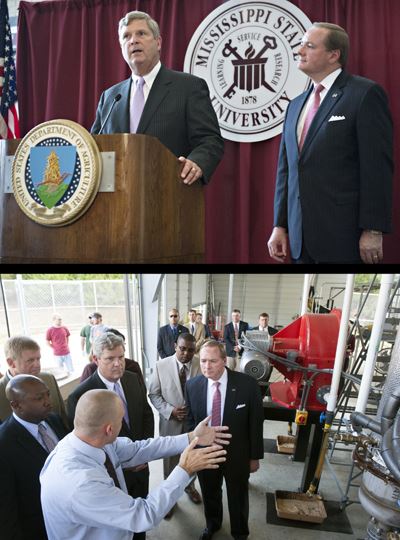|
Vilsack Praises MSU’s Agricultural Research Contributions
STARKVILLE, MISS.
Mississippi State University officials toured U.S. Secretary of Agriculture Tom Vilsack around campus Wednesday in a rare opportunity to brief a sitting Cabinet member on significant federally funded research projects.
Vilsack spent a whirlwind afternoon with MSU researchers and students, learning about ongoing research and answering questions and listening to comments from MSU students.

(Top Photo) PHOTO #1: Secretary of Agriculture Tom Vilsack, left, toured several U.S. Department of Agriculture research projects being conducted on the Starkville campus of Mississippi State University on Wednesday [Sept. 25] and joined MSU President Mark E. Keenum for a press conference after the tour. Keenum is a former Under Secretary of Agriculture. Vilsack also met with a group of students from the Division of Agriculture, Forestry and Veterinary Medicine during his MSU visit.
(Bottom Photo) PHOTO #2: Rubin Shmulsky, a researcher in MSU's Forest Products Lab, demonstrated a process that transforms biomass such as pine chips into fuel.
Photos by: Megan Bean/Beth Wynn
“Mississippi State is targeted right where it needs to be,” Vilsack said. “It’s important to this country that we continue to have a vital economy, and to do that, we have to have production agriculture, and we need to continue to expand agriculture, and particularly export opportunities.
“Here we are at the veterinary school, which basically allows Mississippi producers and others to continue to be productive in agriculture of all kinds,” he said.
MSU ranks ninth in the country by the National Science Foundation for research and development expenditures in agricultural sciences among private and public institutions. In 2011, the university conducted nearly $97 million in agriculture-related research, and last year, the U.S. Department of Agriculture granted MSU more than $28 million in federal research dollars.
“I’m proud of the relationship with have between USDA and Mississippi State,” Vilsack said.
MSU President Mark E. Keenum, a past undersecretary of agriculture, welcomed Vilsack’s interest in MSU research.
“The USDA touches everyone in our country, and one-fourth of income in Mississippi comes from agriculture,” Keenum said. “Secretary Vilsack is over one of the largest departments in the American government, and one that touches practices every American.”
The tour began with Raja Reddy at the Soil-Plant Atmosphere Research Units on MSU’s R. R. Foil Plant Research Center. Reddy, a Mississippi Agricultural and Forestry Experiment Station researcher, showed the SPAR units used to grow crop varieties under a variety of conditions.
“We can control every variable but sunlight,” Reddy said, explaining how factors such as temperature, humidity, water and nutrients can be manipulated to simulate certain growing conditions.
Reddy’s work is looking ahead to expected climate changes as he tests seed varieties performance under climate conditions expected in the future.
“This is cutting edge research that will inform not just what goes on in Mississippi, but all across the United States,” Vilsack said.
At the Bioenergy Pilot Plant, Rubin Shmulsky, a researcher in MSU's Forest Products Lab, demonstrated a process that transforms biomass such as pine chips into fuel.
“Sixty percent of all that goes in comes out as what you want,” Shmulsky said of the fuel-making process.
Vilsack said he intended to use information from this MSU research when he speaks to the U.S. Senate next week on the subject of biofuels.
“The bio-oil production facility utilizes biomass in a new process that uses intense heat to create oil in a matter of minutes as opposed to a matter of centuries,” Vilsack said.
Robbie Kroger, Extension assistant professor of aquatic sciences in the MSU Department of Wildlife, Fisheries and Aquaculture, took Vilsack to a drainage ditch on MSU's Leveck Animal Research Center to demonstrate water conservation and water quality best management practices.
Through the Research and Education to Advance Conservation and Habitat, or REACH, program, Kroger takes innovative management practices for water use and introduces them to producers as a way for them to save money and still maintain yields. The program works by helping landowners address a water management problem, and then these producers tell others about the benefits and savings they experience with the new management techniques.
“The innovative and creative water conservation project here at Mississippi State is a direct link to producers encouraging them to more effectively utilize conservation not only to reduce contamination of water but also to preserve the quantity of water,” Vilsack said.
At the MSU College of Veterinary Medicine, Mark Lawrence spoke of the support the veterinary college provides the aquaculture industry through its two diagnostic labs.
“We have research and diagnostics, all the expertise we need to serve the aquaculture industry,” Lawrence said.
He also noted that MSU’s expertise in warm-water aquaculture species makes the university uniquely qualified to address the aquaculture needs of developing countries, most of which are in warm water regions.
Vilsack’s visit ended with a roundtable session where 25 MSU graduate and undergraduate students discussed the agricultural issues of the day, asking questions and making comments with Vilsack.∆
|
|